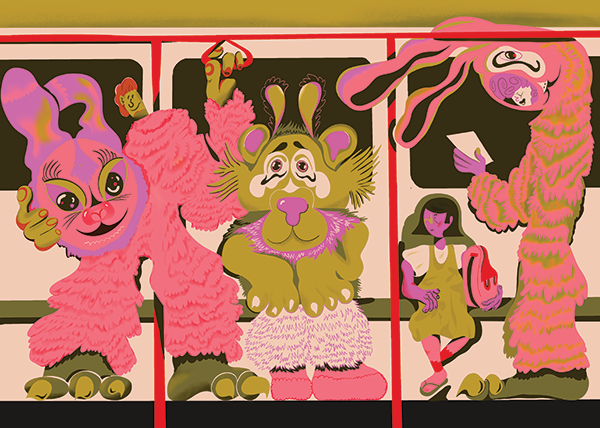It was 2017, and I had a problem.
The subreddit /r/BadEconomics was one of the best places on the internet to discuss economic papers, news, and policy. But, like everything else on the internet, it had been taken over by politics. Stories about Donald Trump, Bernie Sanders, and Hillary Clinton’s emails started dominating the subreddit during the 2016 election cycle. This was driving out discussion of actual economics, and the trend showed no sign of abating. In response, some users suggested a breakaway subreddit where the BadEconomics crowd could discuss politics to their heart’s content. Since the majority of us had supported Hillary Clinton, I joked that we should create a new subreddit named /r/neoliberal
— a nod to attacks from Bernie Sanders fans that Clinton supporters were “neoliberal shills.”
Seven years later, an entire subculture has grown out of that subreddit. Prominent personalities and commentators compete to be crowned the “Chief Neoliberal Shill” each March in a yearly contest. The subreddit, now followed by 175,000 people, has spawned a podcast with millions of downloads, a think tank called the Center for New Liberalism, and scores of local chapters across the U.S. and in almost a dozen countries worldwide. Members of Congress have come to CNL events and proclaimed “I’m a neoliberal” to cheering crowds.
I don’t want to use this space to try to convert you to the gospel of neoliberalism. But I do want to describe the process by which a niche joke on a subreddit became an actual movement with dedicated adherents, lingo and inside jokes, breakaway groups, and a unique value system and culture. As one of the creators of the subreddit and founders of the Center for New Liberalism, I’ve had a front row seat to the genesis of a new community.
Consider this to be a user’s guide to subcultural creation. There’s more than one way, as the saying goes, to skin a cat. But there are general principles that you’ll find useful if you want to build a subculture of your own.
Principle One: Rally ‘round the flag
The first and most obvious thing you’ll need to create a subculture is something to care about.
This principle is far more flexible than you may realize. Subcultures can organize around hobbies or ideologies. They often revolve around politicians, celebrities, or internet personas. They can organize themselves around a technology, a location, or a mission. There are sports subcultures. There are drug subcultures. Occasionally, the organizing principle of a subculture is self-referential. The Something Awful website was one of the most influential sources of internet culture for years, and their dedicated subculture was defined solely by being a member of the Something Awful forums.
I’ll call this the Flag. People are tribal by nature, and they instinctively look for flags to rally around. Sports teams and political parties are obvious ones. Maybe it’s the writings of a popular blogger like Scott Alexander. Maybe it’s Beyoncé. Whatever you choose, giving people an identifiable Flag to stand under is necessary to get started.
Like a real-world flag, a good Flag is distinctive and memorable. It should be easily identifiable, even from a distance. It should give your group a purpose, a reason to gather and form a community. An ideal Flag will scratch a cultural itch, fill a hole that people didn’t even realize needed filling. A Flag gives your group an identity to share. It’ll give you a purpose. It will likely give you a name.
But once you’ve got a name, a common cause, and a shared identity, you’ll need to strengthen it.
Principle Two: Adopt in-group symbolism
Humans, as I will repeatedly note in this guide, are tribal creatures. Even those who seek to escape tribal signifiers and minimize the impact of tribalism end up coining new phrases for their worldview. Perhaps they call themselves free thinkers, non-partisans, or rationalists. They end up creating tribal affiliations, labels, and groupings of like-minded people all the same.
Most subcultures aren’t deliberately created. They arise organically from communities that act in non-directed ways. But there are still things you can learn from how subcultures naturally grow, patterns to how that process happens. How can you harness these patterns? Start with the basics. You’ll want some visual signifiers. Subcultures like punks, goths, or hippies use visual signifiers like particular color schemes, makeup, clothing, and symbols to identify themselves. Political ideologies online often use a particular emoji — a 🌹 denotes a socialist, a 🌐 specifies a neoliberal, and a 🍉 indicates someone who sympathizes with Palestine. People want to rally around Flags, but don’t forget that, in the real world, flags have striking colors and imagery.
As your subculture grows, you’ll also begin to see group-specific phrases and inside jokes develop. Encourage this! These shibboleths function in multiple ways. Sometimes they serve practical uses: in the 1970s, gay men ostensibly adopted the coded term “friends of Dorothy” to identify themselves to other gay men without openly declaring their orientation. Even the term “shibboleth” itself derives from a story in the Hebrew Bible about a pronunciation test used to identify Ephraimites from Gileadites. But even if you’re in no danger of persecution, shared language helps bond the members of your new clan together.
If I were to reference wanting taco trucks on every corner or show you a picture of Janet Yellen with lasers coming out of her eyes, most of you would be confused. But a few of you would get the jokes formed in neoliberal communities and feel a small thrill at being an insider who understood the reference. That’s the point. Mutual recognition of an inside joke or an in-group meme cements a sense of belonging — and is especially thrilling for new members. For the first time, they’re in on the joke.
Embrace all of it. Embrace the goofy jokes and memes. Create lore around your community’s history and why it thinks the way it does. Embrace the canonization, whether ironic or genuine, of “holy figures” for your movement. Holy texts as well — this could be an actual theological tract, but it could also be a particularly beloved set of lyrics, a political text, or even a series of blog posts. Embrace rituals that your group can undertake together. LessWrong’s sequences tell us that every cause wants to be a cult.
I’m telling you that doesn’t go far enough — every group of any kind wants to be a cult. Let them.
This can be overdone. You don’t want to have in-group lingo and practices that are completely indecipherable to outsiders and thus limit your growth. But being unusual and a bit distinctive is good. These images, phrases, and leading figures bind your group together and create a much stronger sense of shared identity than would otherwise be possible. They create allure for those outside, who may be drawn in by curiosity. It’s not by accident that every religion has rituals, saints, and holy texts. And though they’ll use different names, so does every political movement, every sports fandom, every pop culture stan
group.
Imagine a group of people with shared language, dress, and culture, ritually reciting words in unison that are deeply meaningful to them, led by a holy figure. You may think that’s a religious event, but it also describes a Taylor Swift concert. In the end, is there much of a difference?
Principle Three: Define your outgroup
The consequence of building a cultural in-group is that you’re more likely than not to have an out-group.
Sometimes this happens naturally. Socialists will oppose neoliberals. Mets fans will hate Yankees fans. The People’s Front of Judea will despise the Judean People’s Front. But sometimes you won’t have a natural out-group. You may think that you’re just creating a nice community of model train collectors and have no need for an out-group to fight with.
You don’t need an out-group. But you may be surprised by how one might pop up anyways — and how useful it can be.
Tribal conflict is an inherent part of tribal identity, and it shows up in strange places. Famously, if you separate two groups of children at a summer camp, they will develop an intense rivalry without any further instigation.
There is, strictly speaking, no need for fans of pop singers to have enemies. No real benefit comes from holding grudges against other groups. And yet stan communities for musicians are constantly engaging in battles with one another and with the world at large. Entire books have been written about these communities and the battles they engage in,
where there’s no prize to be won other than the glory of defeating another group online. But these battles occur regardless. They’re called stan armies for a reason.
People yearn to fight with an outgroup, even when there’s no logical reason for them to do so. You don’t have to lean into this aspect of tribalism, but doing so can have benefits. Conflicts tend to go viral. They can also heighten a sense of community — especially when it’s another group attacking you first. You are never more intensely committed as a member of a group than when you’re being attacked for your membership. It’s one of the surest ways to fully activate that sense of identity and bring your subculture together. “Rally ‘round the Flag” is a strong enough and predictable enough phenomenon that it has its own Wikipedia page!
So don’t be afraid to pick a fight once in a while. Define your outgroup and watch your community grow.
Principle Four: Build your spaces
No community can exist without a space to congregate in. This could be physical spaces like a church, a stadium, a convention center, or a school. It could also be a digital space like a website, subreddit, or forum.
Spaces are often tied so tightly to a group that they come to define the entire subculture that lives in them. Religious institutions are often defined by their holy sites. Online subcultures may be defined by a particular website.
The spaces your community congregates in are important — sometimes more important than the Flag itself. Speaking for the /r/neoliberal community, many of its members spend their time on the subreddit discussing sports, games, relationships, pop culture and more, often completely divorced from politics. They simply enjoy being in a community of like-minded people and consider the discussion there to be better than they can find elsewhere. Because the space itself is well-moderated and thriving, it attracts and keeps people who otherwise might not have stuck around. A weak Flag with a popular, healthy gathering space is more likely to build a thriving subculture than a strong Flag without a healthy space.
We all know there’s a difference between someone who abstractly believes an idea and someone who deeply identifies with the idea. One person may like Michigan football casually while another person holds “Michigan fan” as a core part of their identity. And you can usually change the former into the latter via the creation of well-maintained subcultural spaces. If you know what MGoBlog is, you might qualify as a real Michigan Wolverine fanatic. If you also regularly visit MaizenBrew.com, if you also have a Rivals account, and if you can navigate Michigan Stadium
with your eyes closed, you definitely identify as a true-blue Michigan fan.
These environments don’t grow on their own. They are gardens that must be tended. Football stadiums don’t sell most of their tickets to the general public, lest the opposing team buy too many and dominate the crowd. They carefully manage the process so that most tickets go to true believers. Digital spaces likewise require moderation. You need to cultivate a place that’s some combination of interesting, dynamic, and fun to hang out in. A mixture of seriousness and silliness is often helpful. But you also need to be able to remove outsiders or troublemakers. If you choose not to, you’ll have to accept a certain level of dysfunction and chaos at the heart of your subculture.
Dynamic communities are powerful things. The internet’s history is littered with sites whose cultural power far exceeds what you’d expect, simply because they had the largest and most dynamic community spaces. Weird Twitter launched the ideology of the “dirtbag left.” 4chan was the laboratory of the modern alt-right. Forums like SomethingAwful, GameFAQs, HackerNews, Bodybuilding.com, TwoPlusTwo and many others spawned actual celebrities, careers, and most of internet culture as we know it. You can build a subculture around nearly anything, so long as you have great spaces and strong community building skills.
So create a subreddit and make sure everyone knows to hang out there. Invite the power users of that subreddit to a group Discord. Stage regular real-world meetups and happy hours. Get those people mingling! Cultural milieus aren’t built out of nothing — they require a shared environment where people are regularly hanging out, interacting, discussing, empathizing, and sharing. These spaces accelerate the process of building a group identity.
Principle Five: Embrace networks
As Kamala Harris would tell you, none of us fell out of a coconut tree. We exist in the context of what came before us. Whatever your group is, it’s unlikely to be the only group of its kind. Recognizing that and using that can be a powerful way to grow your subculture.
What does it mean to exist in context? It means that groups with close connections to existing groups are more likely to grow than groups without any connections. Breakaway movements are usually more successful than wholly original ideas. Many of the world’s most successful religions are offshoots of other religions. Philosophical movements that have strong historical grounding will usually do better than iconoclastic, never-before-seen ideas. Pop culture trends are almost always derivations of (or reactions against) previous trends. You can even extend this idea into unexpected areas like physical sports — most of the world’s most popular sports are related to each other. Baseball was influenced by cricket. Hockey, field hockey, and lacrosse share many features. And football is such a networked term that there’s an entire family of sports that share the name, including American gridiron football, Association football (soccer), Rugby Union football, Gaelic football, and Australian rules football.
These networks are incredibly beneficial. Consider the complicated network between groups like rationalists, effective altruists, effective accelerationists, progress studies enthusiasts, Bay Area technologists, AI researchers, SlateStarCodex fans, and LessWrong members. These groups aren’t the same — some of them don’t even like each other all that much — but they all network with each other. Memberships overlap. They are constantly bumping into one another in similar or shared spaces. They’re interacting, sharing ideas, debating, discussing, and disagreeing. And none of them would have even a fraction of their current influence were it not for the others existing alongside them.
There’s an interesting corollary here — you’ll know your subculture has truly become successful when you start seeing splinter groups form. Splinter groups aren’t a sign you’re dying — they’re a sign you’ve succeeded. The /r/neoliberal subreddit, by my count, has inspired more than a dozen splinter groups — from breakaway subreddits to Discord servers to Minecraft clubs. Some call themselves new liberals, ordoliberals, Democrats, or centrists. But these offshoots are a form of growth. The entire neoliberal/new liberal movement itself is an offshoot of the /r/BadEconomics community.
If you’re lucky, your new subculture will inspire offshoots. New blogs may grow influential communities of their own. Perhaps fine ideological divides will form, and competing subcultures will emerge that agree on 90% of ideas but disagree on the final tenth. So long as these splinter groups aren’t tearing your community apart, this is an encouraging sign. Allow your network to grow alongside your own community.
Principle Six: Surrender to the crowd
Congratulations! You’ve managed to get a subculture off the ground. It’s not that big yet, but it has potential. It’s starting to develop its own lingo, its own set of ideas, memes, and imagery. You have a few dedicated spaces for the community that are growing and thriving. Now comes the hardest part of all: stepping back.
The wisdom of crowds principle says that on average, large groups of people are better at making decisions than individuals would be. This is famously true for oxen
and jelly beans,
but it’s also true for subcultural creation. Even as the subculture’s founder/creator, you won’t be able to fully control how your subculture develops. And you shouldn’t want to.
What memes are the funniest? What appeals can draw in the most new members when shared widely on social media? You might have opinions on this, but the group collective will identify the best ones faster and more accurately than you alone ever could. What actions should your community take to further a cause? Your community members will think of exciting new ideas that wouldn’t even have occurred to you — and may even start implementing those ideas without waiting for permission. Communities are better at the messy process of cultural creation than any individual could be. They’re decentralized. They have varying points of view. And the crowd has countless pairs of eyes to spot new trends whereas you have only one.
Cultural creation is a messy, imperfect process that can’t be neatly controlled. As a leader in your new subculture, your role is to act as a gardener, not an architect. You’re providing the fertile soil in which a thousand flowers can bloom, and you’re planting the seeds. But you won’t get to specify exactly where and how those flowers eventually grow. Your subcultural community is going to make mistakes along the way, but don’t worry. They’re better at this than you could ever be alone.




